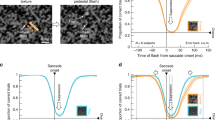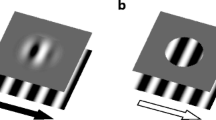Abstract
When a horizontal line is occluded by a surface, subjects misperceive the line as being compressed, that is, they perceive it to be shorter than it really is (Kanizsa’s compression illusion). The size of the compression effect usually ranges from approximately 5 to 10%. In this experiment, subjects executed reflexive saccades from one end of a line, presented at fixation, to the other end, with and without an occluding square. Saccade amplitude was reduced in all subjects in the presence of an occluding square; the effect averaged about 5%. These results demonstrate that saccade amplitude is modified by the Kanizsa compression illusion. They provide further evidence that reflexive saccade amplitude can be altered by illusion inducing stimuli, to the same degree as perceptual effects, even in circumstances in which other motor behaviours resist the illusion. They are difficult to reconcile with any strong version of the “two visual systems hypothesis”.


Similar content being viewed by others
References
Aglioti S, DeSouza JFX, Goodale MA (1995) Size-contrast illusions deceive the eye but not the hand. Curr Biol 5:679–685
Bernardis P, Knox P, Bruno N (2005) How does action resist visual illusion? Uncorrected oculomotor information does not account for accurate pointing in peripersonal space. Exp Brain Res 162:133–144
Binsted G, Elliott D (1999) The Müller-Lyer illusion as a perturbation to the saccadic system. Hum Mov Sci 18:103–117
Bradshaw MF, Watt SJ (2002) A dissociation of perception and action in normal human observers: the effect of temporal delay. Neuropsycholgia 40:1766–1778
Bruno N (2001) When does action resist visual illusions? Trends Cog Sci 5:385–388
Bruno N, Bernadis P (2002) Dissociating perception and action in Kanizsa’s compression illusion. Psych Bull Rev 9:723–730
Bruno N, Bernardis P (2003) When does action resist visual illusions? Effector position modulates illusory influences on motor responses. Exp Brain Res 151:225–237
Carey DP (2001) Do action systems resist visual illusions? Trends Cog Sci 5:109–113
Coren S, Hoenig P (1972) Effect of non-target stimuli upon length of voluntary saccades. Percept Mot Skills 34:499–508
de Grave D, Smeets J, Brenner E (2006) Why are saccades influenced by the Brentano illusion? Exp Brain Res Online. DOI 10.1007/s00221–006–0536–1
Findlay JM (1982) Global processing for saccadic eye movements. Vision Res 22:1033–1045
Findlay JM, Brogan D, Wenban-Smith MG (1993) The spatial signal for saccadic eye movements emphasizes visual boundaries. Percept Psychophys 53:633–641
Goodale MA, Milner AD (1992) Separate visual pathways for perception and action. Trends Neurosci 15:20–25
Goodale MA, Westwood DA (2004) An evolving view of duplex vision: separate but interacting cortical pathways for perception and action. Curr Opin Neurobiol 14:203–211
Haffenden AM, Goodale MA (2000) Independent effect of pictorial displays on perception and action. Vision Res 40:1597–1607
Kanizsa G (1972) Amodal completion and shrinking of visual fields. Studia Psychologica 14:208–210
McCarley JS, Kramer AF, DiGirolamo GJ (2003) Differential effects of the Muller-Lyer illusion on reflexive and voluntary saccades. J Vision 3:751–760
Melcher D, Kowler E (1999) Shapes, surfaces and saccades. Vision Res 39:2929–2946
Walker R, Deubel H, Schneider WX, Findlay JM (1997) Effect of remote distractors on saccade programming: evidence for an extended fixation zone. J Neurophysiol 78:1108–1119
Walker R, Walker DG, Husain M, Kennard C (2000) Control of voluntary and reflexive saccades. Exp Brain Res 130:540–544
Wong E, Mack A (1981) Saccadic programming and perceived location. Acta Psychologia 48:123–131
Acknowledgments
I am grateful to the 2006 graduating class in Orthoptics at the University of Liverpool, who participated in these experiments.
Author information
Authors and Affiliations
Corresponding author
Rights and permissions
About this article
Cite this article
Knox, P.C. The effect of Kanizsa’s compression illusion on reflexive saccades. Exp Brain Res 175, 764–768 (2006). https://doi.org/10.1007/s00221-006-0741-y
Received:
Accepted:
Published:
Issue Date:
DOI: https://doi.org/10.1007/s00221-006-0741-y




